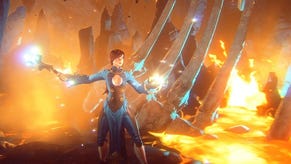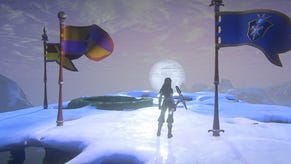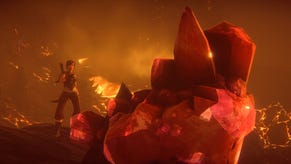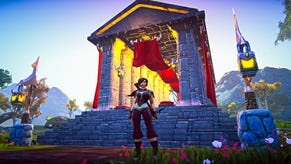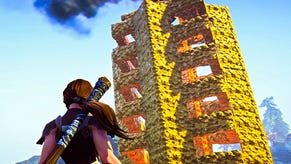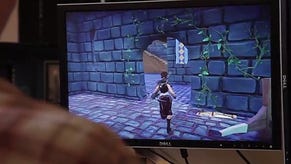First Look: Everquest Next
The next big thing
Yesterday, Sony Online Entertainment significantly altered my entire outlook on the next twelve months of gaming. When I sat down, along with a small gathering of journalists invited to see the reveal of Everquest Next, I wasn’t expecting to have my line of thinking about MMORPGs to fundamentally shift, but that’s precisely what happened. From being a game in a genre that I have only the occasional interest in, Next immediately became one of the most fascinating and exciting games on the horizon.
And that’s just the half of it.
At several moments during the presentation, I wrote in block capitals, circling and underlining. This is the headline feature. This is something nobody has tried or managed to do before. Then, toward the mid-point, while I was still processing what had already come, lead designer Dave Georgeson demonstrated a feature that changed everything.
Everquest Next’s world is made of voxels and everything in it is destructible.
I had to fetch a ladder to retrieve my eyebrows. This is not mere "we've played Minecraft" rhetoric. It's something else. It's big-studio exposure to the kind of things that have been going on in the world of gaming over the past few years. It’s not even a 'feature' as such, it’s the foundation of the tech and design choices, influencing everything that is built on top of it. And everything that is on top addresses the accepted wisdom, or lack of, in the majority of MMOs - enemy behaviour, the unchanging nature of the world, player interactions, combat and the nature of questing have all been overhauled. Or perhaps not even that.
This isn't a reinvention of the wheel, it's the unveiling of a hovercar.
Like so much else that was shown, destructibility could have been little more than a gimmick and was almost introduced as such. That’s because Georgeson knows how to work a crowd. He showed us in-game footage of a fight, which left the battlefield scarred, covered in fresh craters and debris. A wizard destroyed a bridge, sending goblins tumbling to their death. Impressive, and in keeping with the fast-paced, skill-based combat and movement, which is built around weapon-specific fighting styles and parkour elements. It looks like a third-person action game, without the spongey enemies and toe-to-toe power exchanges that plague most of its peers. Great stuff.
Providing elegance and variety to movement and combat, making exploring and fighting interesting activities for their own sake, does solve many of my issues with the WOW (and original Everquest) model. Players still select a race and class to begin with, each having access to four abilities and a couple of weapon types, but they can learn the skills of the other classes as they progress, mixing and matching skills and equipment.
In the battle we were shown, the wizard was Daud-like, blinking through the air, materialising behind enemies and destroying them, sending splinters of rock screaming through the air. The Kah Shir warrior (lion-like now, rather than the tiger-person of yesteryear) charged, sending smaller enemies sprawling, then pouncing from point to point, chaining attacks together, and avoiding spells and the hefty blows of larger creatures.
And then a golem stamped on the players, breaking through the continent’s crust and sending everybody tumbling into a dimly lit subterranean world. They regained their senses and found themselves in a cavern, a procedurally generated space that could link to demonic lairs, forgotten kingdoms or warrens of tunnels, twisting maze-like into darkness.
The lower layers of the world drawn on the thousands of years of Everquest lore, archaeological depths that can be explored and looted, or that can become tombs for the unprepared. Certain spells will allow characters to teleport beneath the surface but any hero can grab a pick and start digging. When everything from the largest structure to the ground itself is a massive collection of changeable voxels, exploration isn’t simply about walking from point to point, it’s about making new routes to previously impossible places.
That's worth saying again: exploration isn’t simply about walking from point to point, it’s about making new routes to previously impossible places.
In an MMO.
Rather than relying on the functional blocks of Minecraft, Next is capable of breaking environments down at the smallest level, leaving jagged scars in the side of hills and allowing for earthquakes that can splinter entire regions, revealing the ancient things below. Some of those ancient things may wake up and emerge, creating new problems and new opportunities.
When a new entity arrives in the world, whether at the developer’s bidding or due to player interference, its behaviour is driven by a series of objectives, needs and desires. Whether an orc bandit or an enormous demon from the depths, a creature is not the product of a spawn point, mindlessly wandering until the proximity of a hero activates its basic functions. It's an AI entity that functions as part of a world. At least that's the claim.
A gang of orcs, for example, won’t simply appear at a specific point in the world, replenishing shortly after they have been eliminated. Instead, when they appear, they react to the changing world. They act as bandits, and their purpose is to steal and murder. Therefore, they’ll lurk near settlements, finding good positions to carry out roadside ambushes as goods and people travel from village to village.
If a group of players start to patrol that road, clashing with the orcs, the parameters change. The AI reinterprets the situation, checking if the threat level is too high and possibly deciding to move on, wandering until it discovers a new suitable location. Or perhaps not. It’s possible that a particular group of players won’t present a strong enough threat, in which case the orcs could become more confident, preparing an assault. Or maybe they have a leader who will call for reinforcements.
The emergent situations created by an AI that is systemically driven carry more potential to change the way Next works as an RPG and online experience than the destructibility, but they’re harder to demonstrate in the short-term. Whether they'll work as intended, we won’t know until the world has been in progress for some time, but that SOE have worked so long to find solutions to problems that most MMO designers don’t even seem to recognise as problems gives me confidence in their approach.
Having an entire world in which human players are competing with reactive AI provides dynamic objectives. If those orcs stray too close to a village, or kill too many merchants and travellers, an NPC may put a bounty on their heads. Alternately, the villagers may ask for better defences, which could lead players into patrol duty, or even gathering resources for teh construction of a palisade or stone walls. It may even be possible to side with the orcs, becoming a raider, and sodding off to the next horizon and leaving the situation to fester is always an option. NPCs remember players’ actions so the consequences of decisions will affect relations and future interactions.
There’s a final addition to the game’s structure that ties everything else together. Keeping with the blank slate approach to the genre, which involves jettisoning a great deal of jargon, larger quests aren’t defined as ‘raids’ or ‘instances’. There will, at any one time, be an over-riding, worldwide mission, which SOE describe as a ‘Rallying Call’. Every single player is part of a Call, although they are free to ignore its objectives. Each one will last for around three months and they will alter the world in a more directed fashion, creating enormous structural changes or new alliances and enmities.
The example described involved the founding of a city. A location is chosen, true to Everquest lore, and the plans for a new settlement are drawn up. The first players to arrive at the spot can set up camp, a few tents, vulnerable in the wilderness. Because people are idiots, they’ve decided to build in goblin country, so the camp will be in immediate danger. Now, every player knows about the quest, and if the attacks become severe, they will be told that help is needed. Quests come with rewards, so heroes may well converge from every corner of the world to assist in the defence and expansion of the camp, eventually making a village, to which NPCs will move. That village will eventually become a city, permanently established in the world, but before that can happen, the goblins must be driven out of the area for good.
Hunting parties could set out into the woods and wilderness, discovering goblin settlements and destroying them, but the nascent settlement will also require a militia to defend its people. Crafters could work in tandem with the hunters, asking them to bring back resources to aid in the construction of sturdier walls, and while the players react, so does the AI, planning counterattacks and possibly gathering all its forces under one ruler to lay siege.
The system has enormous potential. Civil wars, rebellions, elusive villains – my Tolkien-infused brain jumped to the War of the Ring, a multi-pronged epic quest, in which different groups take on varying tasks in far-flung regions of the world. The opportunity not
just to see a world change, but to contribute to that, either as a famous hero or a small cog in a larger war machine.
There are plenty of unanswered questions, and in a game of this scope that is still many months from release, that’s inevitable. Chiefly, I’m interested to see how a world of consequences and change fuses with the mostly inconsequential nature of player death. It is the one problem of the genre (though not unique to the genre) that I didn’t hear any new thinking about.
That was the key to the entire presentation and the interviews that followed. Everquest Next is being constructed by people who have a creative and intellectual fascination with finding new approaches to familiar problems. The solutions are so far-reaching that it barely resembles the games I expected it to be comparable to, including its named predecessors, and the experiment is hugely ambitious. Of course, eliminating problems tends to create new problems, but they’ll almost certainly be interesting problems.
It’s hard to express how large the shift in my expectations was. When John Smedley, CEO of SOE, introduced key members of the team, he gave them a lot to live up to. Twice, he explained, the project has been abandoned and restarted, with eighteen months of work completed each time. There was a fundamental problem. The games they were making had already been made. Static worlds, in which monsters and equipment act as little more than bundles of numbers, and players grind against them for the rest of time.
‘Enough is enough’, he said, ‘we’ve played the same game too many times’. He’s right. When Everquest Next comes out next year, whether it hits the mark on every front or not, it’s going to change our expectations of what an online fantasy world is capable of.
Rather than releasing Everquest 2.5, which would have been far cheaper than this long-haul iterative design, SOE have actually used their talents, thought about what could be done, and understood the time and money that a cooperative big name publisher can provide. They have elected to experiment with the form and attempt something pioneering. I’m struggling to think of another project in development with as much concentrated potential.
More to come, including interviews with all of the key development staff and composer Jeremy Soule. Also, do read about Everquest Next: Landmark if you haven't already.










